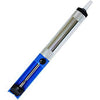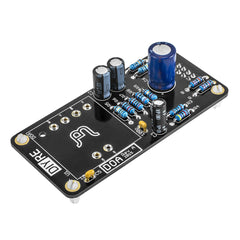DOA Colour Assembly Guide
Damaged or Missing Parts All kits and parts are checked before being shipped to you. If something arrives damaged or if your kit is missing a part, please open a support ticket to inquire about a replacement. Missing parts will be replaced at our expense. Damaged parts should be returned for verification. If the part shows signs of use beyond what was necessary to determine that it was damaged, DIY Recording Equipment, LLC reserves the right not to replace the part.
Thank you for purchasing a DOA Discrete Opamp Colour!
If this is your first DIY project ever, we recommend reading our Getting Started Guide.
Required Tools
You'll need the tools below to complete this build.

Soldering Iron
We recommend an adjustable-temperature station, such as the $40 Weller WLC100.

Solder
You can use 60/40 "leaded" solder or lead-free. We recommend 60/40 because it flows better and is easier for beginners to use.

Wire Cutters
You'll need a pair of good "snips" for cutting of the excess leads after soldering.
Optional Tools
These tools aren't strictly necessary but can make your build a bit easier.

Multi-Meter
If you find the color bands on resistors a bit hard to read, you can use a meter to sort them with absolute confidence.

Desoldering Pump
If you accidentally solder something in the wrong place, a desoldering pump can save the day.
0. Resistor Calculator
Type in the value of the resistor you need and this tool will show you the corresponding color code.
Check Revision
This assembly guide is for Rev A of the DOA Colour, which was discontinued in October 2022. If you bought your kit after October 2022, go to the new DOA Colour assembly guide.
Place Resistors and Capacitors

Sort Components
Open your kit and sort the parts with the Component Sorting Sheet (PDF).
Bag 4 contains two alternate resistors for lower gain, which in turn means less saturation and distortion. If you prefer your DOA Colour to be more aggressive, use only the resistors in bag 1. If you want the DOA Colour to be more subtle, use the resistors in bag 4 for R7 and R9.

Place Resistors
Place the resistors in their respective places on the PCB.

Bend Resistors
As you insert each resistor, bend its leads against the bottom of the PCB to keep it in place.

Solder and Trim Resistors
Now solder the resistors to the PCB. Observe good soldering technique: heat the pad and lead for 2-3 seconds, apply a small bit of solder, and continue to heat the pad for another 2-3 seconds.
Once all of the solder joints have cooled, use your clippers to trim away the excess leads. Your goal should be to clip as close as possible to the joint without clipping the joint itself.

Place Capacitors
Open bag 2 and place the capacitors on the PCB. All of the capacitors are bipolar (can be inserted in either direction), except for C1 and C2. Make sure to place the longer leads of C1 and C2 into the square pads near the "+" marking as shown.
Solder and trim the capacitors as you did with the resistors.
| Part # | Value | Markings | Polarized? |
|---|---|---|---|
| C1, C2 | 100uF | "100uF 25V," black | Yes |
| C3 | 10uF | "10uF 25v," black | No |
| C4, C5 | 100pF | "BC 101," yellow | No |
| C6 | 470uF | "470uF 10V," blue | No |
Place Connectors

Insert Standoffs
Open bag 3 and pop the standoffs into the four mounting holes from the bottom of the PCB. Insert the locking ends with right-angle tabs into the PCB and leave the removable ends to be inserted into your Palette.

Place Sockets on DOA
The DOA sockets are a bit tricky to install, because they're inserted through the top, but soldered from the bottom. The best workaround for this is to place the sockets on the pins of a DOA before placing them in the DOA Colour PCB.
Place the six sockets (your kit should contain one extra) lightly on the pins of any DOA. There's no need to press them all the way down onto the pin.

Place PCB Over Sockets
Now place the DOA Colour PCB over the sockets so that the sockets protrude through the bottom of the PCB. Adjust the positioning of the DOA and PCB until all of the sockets are flush with the top of the DOA Colour PCB.

Solder Sockets
Solder the sockets to the DOA Colour PCB and remove the DOA.

Solder Header
Finally, insert the 8-pin header into the holes marked "CON1." Make sure to place the short, silver pins through the PCB so that the black posts and long, gold pins protrude from the bottom of the PCB. Solder the header to the PCB.
Final Checks
Before you wrap up, check the following things:
-
Capacitor orientation: Is the stripe on the cap on the opposite side from the "+" marking on the PCB?
-
Resistors: Do all of the resistor positions correspond the chart and/or sorting sheet?
-
Soldering: Is every solder joint shiny and clean? If one is cloudy or misshapen, try reheating it for 8 seconds and adding a tiny bit more solder.
-
Trimming: Are all of the excess leads trimmed down as close to the joint as possible?
All good? Congrats on finishing your build! Have a question or problem? Drop us a line.
Help Us Improve
1
2
3
4
5
6
7
8
9
10


